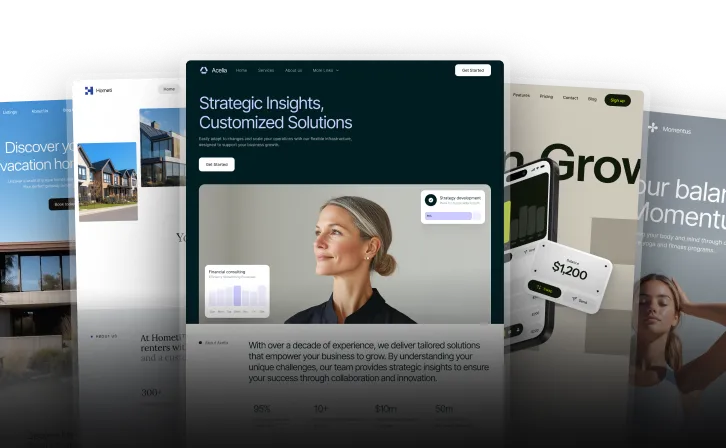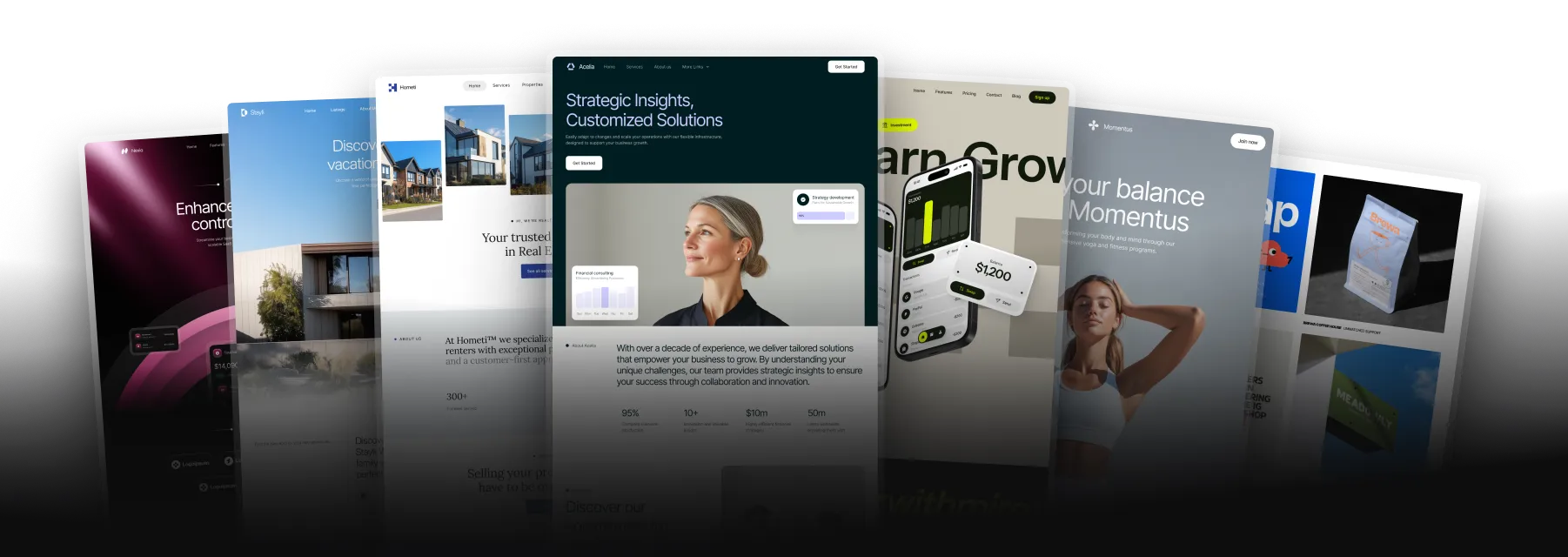Framer vs Shopify: Which Website Builder is Right for You
Unlock all templates




If you're choosing between Framer and Shopify, here's the quick answer:
- Framer is best for design-heavy projects like portfolios, creative websites, and storytelling. It offers a free-form canvas, AI-powered tools, and high customization for visually striking designs. However, it lacks advanced e-commerce tools like inventory management and built-in payment systems.
- Shopify is ideal for e-commerce businesses. It provides robust tools for online and offline sales, including payment processing, inventory management, and a large app marketplace. Its design options are more limited but easier for beginners.
Quick Comparison
| Feature | Framer | Shopify |
|---|---|---|
| Best For | Design-focused websites | E-commerce businesses |
| Design Flexibility | Free-form canvas, highly customizable | Template-based, limited adjustments |
| E-commerce Tools | Basic, relies on third-party add-ons | Full suite for online/offline sales |
| Learning Curve | Moderate to steep | Beginner-friendly |
| Pricing | Free to $30/month | $39 to $399/month |
Key takeaway: Choose Framer for creative freedom and design; choose Shopify for selling and scaling your business.
Feature Comparison
Design Tools
Framer provides a free-form canvas, giving users full control over their designs, much like Figma does. This approach allows for detailed and unconstrained customization.
On the other hand, Shopify uses mobile-responsive, template-based designs that prioritize quick and straightforward setup. However, this comes with limitations. As one user shared:
"Shopify is at good as it is for selling it is at the same time a very poor and unflexible for designing it. If you have no idea of coding you will be stuck many times."
Online Store Features
Both platforms cater to e-commerce but in different ways:
| Feature | Shopify | Framer |
|---|---|---|
| Payment Processing | Built-in Shopify Payments | Third-party integrations |
| POS System | Included for in-person sales | Not available |
| Inventory Management | Robust inventory tools | Limited; relies on add-ons |
| App Marketplace | Over 13,000 apps | Smaller selection |
Shopify stands out with its all-in-one toolkit, including a built-in point-of-sale system for both online and offline sales. Framer Commerce, meanwhile, focuses on visual, code-free store creation tied to Shopify. However, its core e-commerce functionality depends on integrations like Stripe or PayPal.
Learning Requirements
Shopify's user-friendly dashboard and pre-designed themes make it accessible for beginners. Framer, however, leans more toward design professionals, requiring some knowledge of JavaScript and CoffeeScript for advanced customizations. This difference in complexity also impacts their respective pricing models.
Cost Breakdown
Shopify offers a straightforward pricing structure and includes a free trial period. Framer, while emphasizing design flexibility, relies on third-party integrations for e-commerce functionality. Up next, we'll explore the strengths and limitations of each platform in greater detail.
Framer Analysis

What Framer Does Well
Framer stands out for giving designers plenty of creative freedom thanks to its free-form canvas approach. Its AI-powered tools allow users to generate code from plain text, making it a great option even for those who don’t know how to code.
The platform’s visual editor and robust component library make it easy to create designs quickly. It offers customizable layouts, typography, animations, and interactions. Plus, Framer's marketplace includes over 1,000 free templates for various project types. Integration with Figma ensures a smooth transfer of portfolio layers, frames, and auto layouts. However, while Framer excels in design, it sacrifices some practical functionality.
Where Framer Falls Short
Framer lacks essential features for online selling, such as detailed inventory management, built-in payment gateways, and advanced product catalog tools. Its CMS collections struggle with managing large or complex datasets, and its SEO tools aren’t as robust as those offered by competitors like Webflow.
The limited marketplace also poses challenges for businesses requiring extensive third-party integrations. As one user puts it:
"Limited third-party integrations make it hard to connect with other tools we use".
Framer Quick Facts
| Aspect | Details |
|---|---|
| Best For | Design-focused websites, portfolios, and creative agencies |
| Pricing | Free plan available; Paid plans: Mini ($5/month), Basic ($15/month), Pro ($30/month) |
| Key Strengths | AI-powered design tools, advanced visual editor, responsive layouts |
| Main Limitations | Lacks advanced e-commerce tools, basic SEO features, limited integrations |
| Learning Curve | Moderate to steep; detailed video tutorials provided |
| User Rating | 3.8 out of 5 based on user reviews |
Shopify Analysis

What Shopify Does Well
Shopify shines when it comes to e-commerce tools and business management. It supports over 100 payment gateways, and its cloud-based system ensures smooth performance, even during high traffic. The platform's app marketplace allows businesses to add extra features, and its multichannel integration makes it easy to handle both online and in-person sales through its built-in Point of Sale (POS) system.
Real-world success stories back up Shopify's capabilities. For example, Dollar Shave Club reduced tech maintenance by 40% and gained 100 million users. Similarly, Boston Proper saw conversion rates increase by 4% using Shopify Checkout. However, despite these strengths, Shopify does face some notable challenges in design and customization.
Where Shopify Falls Short
Shopify's design relies heavily on templates, which can feel limiting. Pair that with premium costs and restricted customization options, and it raises concerns about its flexibility. Additionally, extra charges for premium themes and must-have apps make the pricing less attractive, especially for businesses that aren't strictly focused on e-commerce. Users have also pointed out issues with the responsiveness of Shopify's support team.
Shopify Quick Facts
| Aspect | Details |
|---|---|
| Best For | E-commerce businesses, multichannel sellers, and retail operations |
| Pricing Plans | Basic: $39/month, Shopify: $105/month, Advanced: $399/month |
| Key Strengths | Multiple payment gateways, extensive app marketplace, inventory tools |
| Main Limitations | Limited design flexibility, higher costs, support responsiveness issues |
| User Rating | 3.9 out of 5 based on user reviews |
sbb-itb-fdf3c56
Framer vs Shopify - Which E-Commerce Platform is Better? (Full Comparison)
Platform Selection Guide
This guide helps you decide which platform works best for your project by focusing on their strengths and ideal use cases.
Best Uses for Framer
Framer shines when visual design and creative freedom are top priorities. Its free-form canvas and prototyping tools make it a go-to for interactive websites with minimal coding, ideal for those who want to leave a strong visual impression.
"Framer is the ideal choice for businesses that prioritize design flexibility and creativity, making it perfect for portfolios, design agencies, and visually focused websites." – Teodor Iliev, Founder of Wize Design and Wize Templates
Framer is a great fit for:
- Design agencies showcasing their work
- Freelance designers building portfolios
- Creative studios needing standout websites
- Small businesses focused on storytelling through visuals
- Projects that emphasize visual content
Best Uses for Shopify
Shopify is the better choice for businesses centered on e-commerce. It offers tools for selling, payment processing, and shipping, making it a powerful platform for online merchants.
Shopify works best for:
- Retailers selling both online and in physical stores
- Sellers targeting international markets with multi-currency support
- Merchants needing an all-in-one e-commerce solution
- Businesses requiring reliable payment and shipping tools
Project Type Comparison
Here’s a breakdown of how each platform aligns with different project needs:
| Project Type | Recommended Platform | Key Deciding Factors |
|---|---|---|
| Creative Portfolio | Framer | Flexible design, interactive features, and high customization |
| E-commerce Store | Shopify | Complete e-commerce tools, payment integration, and inventory management |
| Design Agency Website | Framer | Unique visual presentation and advanced prototyping options |
| Multi-channel Retail | Shopify | POS integration, multichannel selling, and streamlined logistics |
| Digital Product Showcase | Framer | Interactive layouts and design-focused features |
| Large Online Store | Shopify | Scalable tools, strong e-commerce features, and multiple payment options |
| Brand Story Website | Framer | Customizable layouts and storytelling-focused design |
| Small Business Store | Shopify | Easy setup, pre-designed themes, and built-in business tools |
The right platform depends on your goals. If you aim to create a visually striking website with full creative control, Framer is the way to go. On the other hand, if your focus is on running an online store with powerful e-commerce features, Shopify has the tools you need.
Conclusion
Main Differences
Framer and Shopify each cater to distinct needs. Framer stands out for its free-form canvas, offering unmatched design freedom, which appeals to creative professionals. Shopify, on the other hand, is built for e-commerce, packed with tools tailored for online businesses. These differences make Framer ideal for design-focused projects, while Shopify shines in the e-commerce space.
Your choice will depend on what your project prioritizes - design flexibility or business and sales functionality.
Platform Choice Tips
Here’s a quick guide to help you decide:
-
Go with Framer if you need:
- A design-focused, visually stunning website
- A platform for portfolios or storytelling
- Basic site functionality without advanced e-commerce tools
- Maximum creative control over design
-
Opt for Shopify if you need:
- A complete e-commerce platform
- Built-in payment processing and multiple gateways
- Tools for managing inventory and orders
- Multi-channel sales options
Shopify is well-suited for businesses looking to scale, thanks to its tiered plans that grow with your needs. While Framer provides a lower-cost entry point, expanding businesses may find themselves needing extra tools and integrations over time.
Shopify’s marketplace, with over 13,000 integrations, makes it a powerhouse for e-commerce solutions. Framer, though less equipped with third-party options, remains the better choice for projects centered around design rather than complex sales features.
Related Blog Posts
Recommended posts
Unlock all templates







